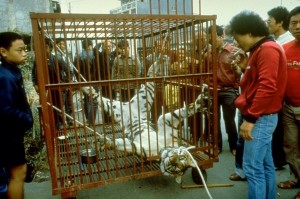Campaign Example: EarthTrust Tiger Campaign
Funded by pioneering asian-wildlife activist Suwanna Gauntlett, ET conducted a multi-year campaign to save wild tigers which spun off many projects and initiatives by other organizations.
There is no current funding for the Tiger campaign at ET, but we remain committed to saving the tiger and the species which share its habitat, even though the tigers’ situation is pretty desperate.
We’ve had a fair bit of success. ET’s undercover documentary teams obtained dramatic (and unsettling) footage of the reality of today’s tiger trade, in which caged live tigers have their component parts auctioned off and are then dismembered on the spot. These images were used for a national and international program of full-page newspaper ads by a consortium of conservation groups, in one of the hardest-hitting tiger campaigns ever.
An extensive market survey of tiger parts in Taiwan was compiled by ET’s Keith & Susie Highley. The data confirmed the continuing demand for a variety of tiger parts, despite domestic laws which prohibit trade in endangered species. The Highleys developed a five-point Action Plan for Taiwan which emphasizes effective law enforcement and education as necessary steps toward ending the consumption of tiger parts. EarthTrust efforts have also included providing information and documentation to Washington DC State Department and USFWS officials regarding Taiwan’s promises to take concrete steps to shut down the trade in rhino horn and tiger parts. We support legislative measures designed to ensure strengthened legislation, enforcement and penalties concerning the sale and possession of endangered species products.
Wild tigers will disappear this century unless major action by conservationists prevent it. Want to help? Get in touch.
EarthTrust and the Tiger
The effort to save the tiger has taken us to many places.
Frankly, it may not be a fight that can be won. Certainly the situation of wild tigers is pretty desperate. They’re large carnivores which require a lot of area… and of course, they are potential human predators. They live in parts of the world with high human populations.
An individual tiger is worth more than its weight in gold on the black market, since the legends of oriental medicine claim that eating various parts of a tiger – its bones, its penis, its hair, its flesh, etc – has near-magical effects for the wealthy who can afford it.
Join with us. Saving the tiger in the wild is definitely difficult, and may be impossible – but the effort to do so is worthwhile, and may protect countless other species which live alongside the tiger.
It’s reasonable to say that tigers are no longer human predators except – like sharks – in rare cases. By contrast, our species is eating tigers as fast as they can fall through the cracks into international commerce.
Isn’t it a more interesting world with wild tigers alive in it?




